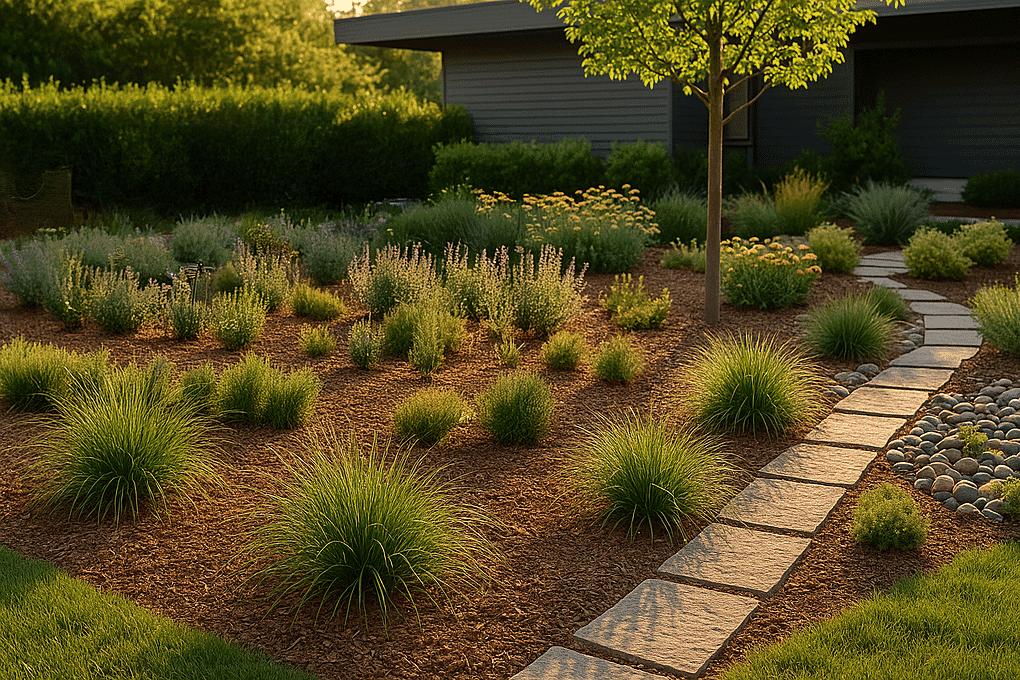Blog
Sustainable & Climate-Adaptive Landscaping Practices for the Modern Property Owner
Introduction: Landscapes Built for the Future
Landscape professionals worldwide are encountering a new reality characterized by hotter summers, unpredictable rainfall, and rising client expectations for greener, more resilient outdoor spaces. In this current climate, sustainable and climate-adaptive landscapes have become essential rather than optional.
Today’s property owners seek not only beauty but also long-term performance. Sustainable landscaping combines ecological principles with design to create outdoor spaces that thrive with reduced water usage, minimal waste, and greater harmony with nature.
1. What “Climate-Adaptive” Really Means
Climate-adaptive landscaping starts with understanding your local environment. Every site has its own unique microclimate, including sun exposure, soil type, humidity, wind, and rainfall patterns, which significantly shape its success.
For example, a property in Phoenix demands drought-tolerant desert flora and smart irrigation systems, while a Seattle garden thrives on rain-fed native ferns and permeable pathways. Adaptive design means aligning with nature’s logic instead of forcing uniformity across regions.
2. The Core Principles of Sustainable Landscape Design
Native and Climate-Appropriate Plants
Native plants are the cornerstone of sustainable design. They’re evolved to local conditions, meaning they need less water, fertilizer, and pest control. Think lavender, ornamental grasses, coneflowers, or local shrubs that attract pollinators and birds. Native gardens are vibrant ecosystems, not just decorative spaces.
Smart Water Use and Efficient Irrigation
Water scarcity is a growing concern for both property owners and municipalities. Modern irrigation systems utilize rain sensors, soil moisture monitoring, and weather-based controllers to minimize waste. Drip irrigation, when properly installed, delivers water precisely where plants need it, minimizing evaporation and runoff.
Soil Health: The Unsung Hero
Healthy soil is the foundation of every resilient landscape. Compost, mulch, and organic matter enhance structure, improve drainage, and support beneficial microbes. A simple principle applies: feed your soil, not your plants.
3. Designing for Sustainability
Permeable Surfaces and Stormwater Management
Permeable pavers, rain gardens, and bioswales allow water to soak back into the ground instead of flooding storm drains. These systems protect local waterways while reducing erosion and heat buildup.
Energy & Material Efficiency
From recycled stone to locally sourced lumber, responsible material choices reduce transportation emissions and support local economies. LED or solar-powered lighting enhances ambiance while cutting energy use.
Edible and Functional Landscapes
Today’s clients increasingly want spaces that give back. Herbs, berries, and fruiting shrubs blend beauty with practicality, turning landscapes into living pantries. Edible gardens are part of a broader “wellness” movement connecting people with the land.
4. Technology’s Role in the Sustainable Landscape
Innovation is driving a quieter, cleaner future for landscape maintenance. Smart design apps help visualize efficient planting layouts and drainage systems. Husqvarna’s battery-powered and autonomous tools, such as the Automower®, minimize emissions and noise while improving precision.
Technology doesn’t replace craftsmanship; it enhances it. When professionals pair smart tools with ecological design, sustainability becomes seamless.
5. Maintenance: Sustainability as an Ongoing Practice
True sustainability is measured over time. Adaptive landscapes require careful observation, including adjusting irrigation, monitoring plant health, and responsible pruning. By avoiding synthetic fertilizers and harsh chemicals, we can protect pollinators and enhance soil resilience.
For property owners, conducting an annual “sustainability check” is essential. This involves evaluating water use, plant performance, and soil condition to ensure the landscape remains healthy and cost-efficient.
Conclusion: Working With Nature, Not Against It
Sustainability is not a passing trend. It’s a mindset that shapes how we design, build, and care for the land. By combining native ecology, efficient technology, and thoughtful design, today’s professionals are crafting landscapes that endure, True sustainability is measured over time. Adaptive landscapes require careful observation, including adjusting irrigation, monitoring plant health, and responsible pruning. By avoiding synthetic fertilizers and harsh chemicals, we can protect pollinators and enhance soil resilience.
For property owners, conducting an annual “sustainability check” is essential. This involves evaluating water use, plant performance, and soil condition to ensure the landscape remains healthy and cost-efficient.beautiful spaces that work with nature instead of against it.
As more clients demand meaningful, climate-resilient outdoor spaces, one truth stands out: the most successful landscapes are those that adapt, evolve, and thrive.
Pro Tip for Clients: How to Talk About Sustainability With Your Landscaper
Stay tuned for our companion article, a guide to asking the right questions, selecting the right materials, and building a shared vision for an eco-friendly outdoor space.

